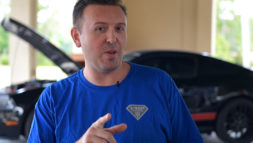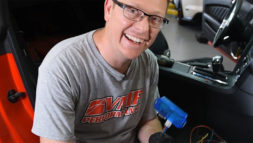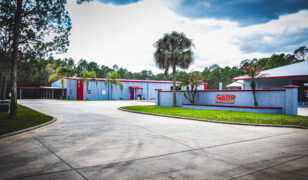- Home
- Customer Builds
- Boost vs Boost—Ported Trinity 2.3 L takes on VMP Performance Gen3 2.65 L TVS
Boost vs Boost—Ported Trinity 2.3 L takes on VMP Performance Gen3 2.65 L TVS
Estimated reading time: 3 minutes
…
Supercharger on Jon Lund’s 1,100 Horsepower Shelby GT500
By Evan J. Smith
It wasn’t too long ago when turning a Mustang up to make 600 or 700 horsepower was a big deal. Today, using modern supercharging technology, like a VMP Performance Gen3 2.65 L TVS, it’s possible to blow past 1,000 horsepower, not just at the crank, but at the wheels.
A prime example is John Lund’s amazing 2014 Shelby GT500; it recently laid down mind-altering 1,102 ponies to the tires. This nearly doubles the factory output of a stock GT500 and provides insane acceleration when Lund mashes the gas.
“[My car is] one of the last 2014 GT500s built,” said Jon Lund of Lund Racing. “It’s silver with blue stripes and I got it in May of 2013. It’s a great car. It’s had a Trinity 2.3 L blower almost all its life. Basically, it’s had the same setup for the last two or three years. This includes long-tube headers and cat-back, L&M Engines cams, ID1300 injectors, a fuel pump booster, and a ported stock blower,” he explained.
“We’ve used the Mustang as a test bed for different throttle bodies and ended up doing an X.B.A. elbow from Power By The Hour to adapt a Kenne Bell 168 mm throttle body. It made 881 rwhp and 840 lb·ft of torque and ran 10.22 at 140 mph. This was at full weight on drag radials and with stock front tires,” he added.
New Engine, More Power
“I started collecting parts and eventually built a new engine,” he said. “I wanted to try the new VMP Performance Gen3 supercharger and make big power so I updated the engine. L&M Engines sleeved the stock block and we went with Manley M300 rods with Diamond 11.2:1 compression pistons that are forged and coated. The stock crank is pretty good so I stuck with it,” he added.
Steve Slawko (Slawko Racing Heads, Morgantown, Pennsylvania) massaged the cylinder heads. He performed a CNC-port job and installed stiffer springs. “I put the long-block together myself with main studs and head studs and reinstalled the ported stock blower to get a baseline. It cracked 916 horsepower and 839 lb·ft of torque at the wheels. That was with MS109 fuel.” The pulley combination consisted of a 2.4-inch and ATI 10 percent overdriven lower. “It peaked around 17-18 psi of boost and 16 psi at top rpm. That was with 18 degrees of timing.” Jon said. It also benefits from a Kenne Bell Bigun Intercooler.
“We removed the Trinity blower and installed the VMP Gen3 2.65 L TVS. I used the same Kenne Bell throttle body, so it was really just a blower swap. I lowered the timing to 13 degrees and put 93-octane Sunoco pump gas in the tank. We wanted to match the boost level, so we swapped to a 2.8 upper and used the same ATI lower. It was amazing, you could lay the boost curve over each over,” Jon stated. “It made 909 horsepower and 814 lb·ft of torque on pump gas! That compared to 916 with 18-19 degrees of timing on the 2.3 L blower. This Gen3 is legit. And with a baseline like that, I knew it was going to make more power.”
Jon added Torco octane booster to the tank and dialed in 17 degrees of timing. Output jumped to 960 rwhp with the same boost level that produced 881 rwhp with the ported 2.3 L blower.
“At that point, we wanted to turn up the boost. I installed a return-style fuel system and converted to E85 fuel. We swapped from the 2.8-inch pulley to the 2.4-inch pulley and the GT500 produced 1,087 rwhp and 968 lb·ft of torque. Boost was up to a peak of 22 psi and 20 psi above 5,500 rpm. It makes so much torque that I don’t have to rev it much past 7,000 rpm,” he added.
“That’s most we made so far with E85,” Jon said. But one more hero run was in order. Jon added two degrees of ignition timing and was rewarded with 1,102 horsepower and 983 lb·ft of torque at the wheels! “The VMP Gen3 is an awesome blower,” Jon said with a smile. “It’s really impressive, it moves some serious air and keeps the torque in, which I really like. It is a nasty car. Actually, I had to lower the boost for street driving because at 85-90 mph it breaks the tires loose,” Jon said. “Now it’s a nice combination. With the Trinity blower, it just ran out of steam. But the new combination can make more; I think the restriction is the headers. We need bigger headers, which would add about 30 hp,” he explained.
Jon Lund’s GT500 currently breathes through American Racing Headers 1 7/8-inch headers with a 3-inch collector. Jon would like to install 2-inch headers with a 3 ½-inch collectors. “After that, the only thing I’d like to do is to put a 15 percent overdriven lower on there. That would crank things up and I think we can get past 1,200 rwhp.”
Tags:
2014 GT500American Racing HeadersDiamond PistonsEvan Smithfordford mustangFuel Pump BoosterGT500ID1300 InjectorsJon LundKenne BellL&M CamsL&M EnginesLund racingLund TuningManley M300 rodsmustangPower By the HourShelby GT500Slawko Racing HeadsSteve SlawkoThrottle BodyTorcoVMP Gen3vmp performancevmp tuningVMP TVS













